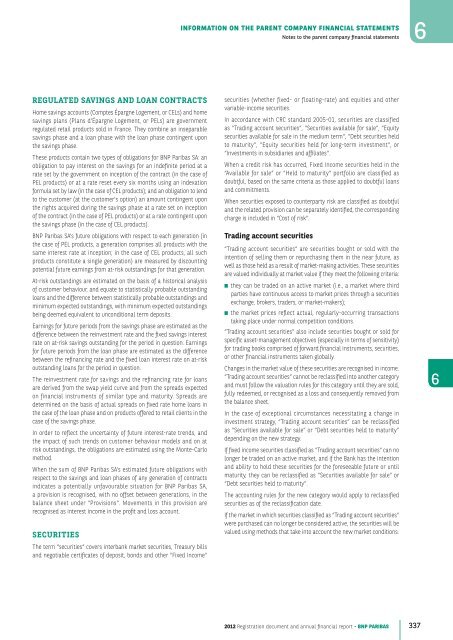2012 Registration document and annual financial report - BNP Paribas
2012 Registration document and annual financial report - BNP Paribas
2012 Registration document and annual financial report - BNP Paribas
- No tags were found...
You also want an ePaper? Increase the reach of your titles
YUMPU automatically turns print PDFs into web optimized ePapers that Google loves.
INFORMATION ON THE PARENT COMPANY FINANCIAL STATEMENTSNotes to the parent company <strong>financial</strong> statements6REGULATED SAVINGS AND LOAN CONTRACTSHome savings accounts (Comptes Épargne Logement, or CELs) <strong>and</strong> homesavings plans (Plans d’Épargne Logement, or PELs) are governmentregulated retail products sold in France. They combine an inseparablesavings phase <strong>and</strong> a loan phase with the loan phase contingent uponthe savings phase.These products contain two types of obligations for <strong>BNP</strong> <strong>Paribas</strong> SA: anobligation to pay interest on the savings for an indefinite period at arate set by the government on inception of the contract (in the case ofPEL products) or at a rate reset every six months using an indexationformula set by law (in the case of CEL products); <strong>and</strong> an obligation to lendto the customer (at the customer’s option) an amount contingent uponthe rights acquired during the savings phase at a rate set on inceptionof the contract (in the case of PEL products) or at a rate contingent uponthe savings phase (in the case of CEL products).<strong>BNP</strong> <strong>Paribas</strong> SA’s future obligations with respect to each generation (inthe case of PEL products, a generation comprises all products with thesame interest rate at inception; in the case of CEL products, all suchproducts constitute a single generation) are measured by discountingpotential future earnings from at-risk outst<strong>and</strong>ings for that generation.At-risk outst<strong>and</strong>ings are estimated on the basis of a historical analysisof customer behaviour, <strong>and</strong> equate to statistically probable outst<strong>and</strong>ingloans <strong>and</strong> the difference between statistically probable outst<strong>and</strong>ings <strong>and</strong>minimum expected outst<strong>and</strong>ings, with minimum expected outst<strong>and</strong>ingsbeing deemed equivalent to unconditional term deposits.Earnings for future periods from the savings phase are estimated as thedifference between the reinvestment rate <strong>and</strong> the fixed savings interestrate on at-risk savings outst<strong>and</strong>ing for the period in question. Earningsfor future periods from the loan phase are estimated as the differencebetween the refinancing rate <strong>and</strong> the fixed loan interest rate on at-riskoutst<strong>and</strong>ing loans for the period in question.The reinvestment rate for savings <strong>and</strong> the refinancing rate for loansare derived from the swap yield curve <strong>and</strong> from the spreads expectedon <strong>financial</strong> instruments of similar type <strong>and</strong> maturity. Spreads aredetermined on the basis of actual spreads on fixed rate home loans inthe case of the loan phase <strong>and</strong> on products offered to retail clients in thecase of the savings phase.In order to reflect the uncertainty of future interest-rate trends, <strong>and</strong>the impact of such trends on customer behaviour models <strong>and</strong> on atrisk outst<strong>and</strong>ings, the obligations are estimated using the Monte-Carlomethod.When the sum of <strong>BNP</strong> <strong>Paribas</strong> SA’s estimated future obligations withrespect to the savings <strong>and</strong> loan phases of any generation of contractsindicates a potentially unfavourable situation for <strong>BNP</strong> <strong>Paribas</strong> SA,a provision is recognised, with no offset between generations, in thebalance sheet under “Provisions“. Movements in this provision arerecognised as interest income in the profit <strong>and</strong> loss account.SECURITIESThe term “securities“ covers interbank market securities, Treasury bills<strong>and</strong> negotiable certificates of deposit, bonds <strong>and</strong> other “Fixed Income“securities (whether fixed- or floating-rate) <strong>and</strong> equities <strong>and</strong> othervariable-income securities.In accordance with CRC st<strong>and</strong>ard 2005-01, securities are classifiedas “Trading account securities“, “Securities available for sale“, “Equitysecurities available for sale in the medium term“, “Debt securities heldto maturity“, “Equity securities held for long-term investment“, or“Investments in subsidiaries <strong>and</strong> affiliates“.When a credit risk has occurred, Fixed Income securities held in the“Available for sale“ or “Held to maturity“ portfolio are classified asdoubtful, based on the same criteria as those applied to doubtful loans<strong>and</strong> commitments.When securities exposed to counterparty risk are classified as doubtful<strong>and</strong> the related provision can be separately identified, the correspondingcharge is included in “Cost of risk“.Trading account securities“Trading account securities“ are securities bought or sold with theintention of selling them or repurchasing them in the near future, aswell as those held as a result of market-making activities. These securitiesare valued individually at market value if they meet the following criteria:■ they can be traded on an active market (i.e., a market where thirdparties have continuous access to market prices through a securitiesexchange, brokers, traders, or market-makers);■ the market prices reflect actual, regularly-occurring transactionstaking place under normal competition conditions.“Trading account securities” also include securities bought or sold forspecific asset-management objectives (especially in terms of sensitivity)for trading books comprised of forward <strong>financial</strong> instruments, securities,or other <strong>financial</strong> instruments taken globally.Changes in the market value of these securities are recognised in income.“Trading account securities” cannot be reclassified into another category<strong>and</strong> must follow the valuation rules for this category until they are sold,fully redeemed, or recognised as a loss <strong>and</strong> consequently removed fromthe balance sheet.In the case of exceptional circumstances necessitating a change ininvestment strategy, “Trading account securities” can be reclassifiedas “Securities available for sale” or “Debt securities held to maturity”depending on the new strategy.If fixed income securities classified as “Trading account securities” can nolonger be traded on an active market, <strong>and</strong> if the Bank has the intention<strong>and</strong> ability to hold these securities for the foreseeable future or untilmaturity, they can be reclassified as “Securities available for sale” or“Debt securities held to maturity”.The accounting rules for the new category would apply to reclassifiedsecurities as of the reclassification date.If the market in which securities classified as “Trading account securities”were purchased can no longer be considered active, the securities will bevalued using methods that take into account the new market conditions.6<strong>2012</strong> <strong>Registration</strong> <strong>document</strong> <strong>and</strong> <strong>annual</strong> <strong>financial</strong> <strong>report</strong> - <strong>BNP</strong> PARIBAS 337





